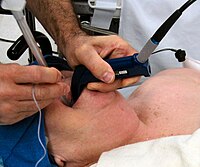
Photo from wikipedia
Purpose Facial fractures are a harbinger when it comes to airway management. Facial fractures can cause airway obstruction or preclude the use of intubation. We aim to examine the etiologies,… Click to show full abstract
Purpose Facial fractures are a harbinger when it comes to airway management. Facial fractures can cause airway obstruction or preclude the use of intubation. We aim to examine the etiologies, types of facial fractures, and the risk factors that may lead to requirement of an advance airway. Methods A retrospective chart review was performed of all facial fractures in the adult population in a level 1 trauma center in an urban environment (University Hospital in Newark, NJ). Patient demographics were collected, as well as location of fractures, concomitant injuries, and course of hospital stay. Results During the period examined, 2626 patients were identified as 18 years or older and with facial fracture. Among these patients, 443 received airway management. Mean age was 34.21 years (range, 18–95 years), with a male predominance of 91.9%. One hundred nineteen patients were intubated on, or before, arrival to the trauma bay. One hundred three patients required surgical airways on arrival to the trauma bay, and 91 of these patients were also reported to have been intubated before arrival. There were a total of 741 fractures identified on radiologic imaging. The most common fractures observed were orbital fractures, frontal sinus fractures, and nasal fractures. Mean Glasgow Coma Scale score on arrival was 9.45 (range, 3–15). Gunshot wound was also the most common etiology among those who were intubated and those who received a surgical airway. The most common concomitant injuries were traumatic brain injury, intracranial hemorrhage, and skull fracture. Forty-one patients died, most of which were intubated during their hospital course. Conclusions There is a dearth of literature detailing standardization of airway management for patients who present with facial fractures. The difference between intubation and surgical airway is often a subjective judgment call, but the authors believe that a more streamlined process can be elucidated after analyzing previous trends as well as variabilities in patient survival and prognosis.
Journal Title: Annals of Plastic Surgery
Year Published: 2019
Link to full text (if available)
Share on Social Media: Sign Up to like & get
recommendations!